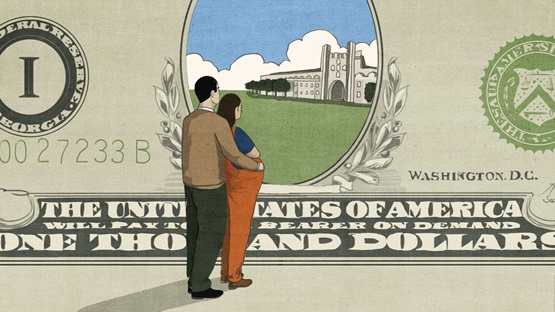For millions of working parents and the businesses that need their labor, a healthy child care sector is essential. Investments to sustain—and, potentially, improve—the child care market as the economy recovers from the effects of the COVID-19 pandemic must reflect the challenges and opportunities presented by that market’s particular structure.
This brief describes historic and contemporary trends in the child care sector. It then presents a framework for policy choices during the COVID-19 pandemic, organized around the following considerations:
- The pandemic has substantially increased the cost of providing child care. Pandemic-related limits on group sizes at child care centers reduce center revenue and increase the per-child cost of providing care. Home-based family child care providers that serve more than eight or nine children may also face reductions in revenue. Both provider types face additional costs for cleaning supplies, sanitization equipment, and facility changes.
- Financial assistance should target child care providers’ fixed costs. Three factors suggest that supporting child care providers’ ability to pay fixed costs, like their rent and utility bills, will improve the long-term supply of child care options for families with young children. First, during the pandemic, fixed costs remain in place (or may increase) even as revenues are often decreasing. Second, smaller group sizes—which aim to limit COVID-19 transmission—prevent many child care providers from maintaining pre-pandemic staffing levels. And third, the market can be difficult for new businesses to enter, making it especially important to retain existing providers.
- Policymakers should use transparent criteria in awarding funds. For example, they could prioritize providers that have the capacity to serve during the pandemic as well as those that serve children from low- to moderate-income families. Ensuring that child care is available across diverse geographies and communities is another possible criterion.
- Approaches to relief can respond to changing conditions. Future developments depend on the spread of COVID-19, fiscal policy choices, and the responses of consumers and employers to these factors. As economic conditions change, policy can be designed to do to the same.
This brief complements the Briefing on Child Care Funding and Policy Considerations in Response to COVID-19, recently developed by a Federal Reserve System work group on child care system challenges and published by the Federal Reserve Bank of Atlanta.
Pre-pandemic child care market conditions
Roughly 15 million young children live in a home where all adults participate in the labor force. Without the child care industry, many of those adults would not be able to do so. And high-quality child care benefits society at large: evidence shows that public investments in high-quality early care and education for low-income families yield a high rate of return.
A majority of expenditures on child care in the U.S. come from households, which spend about $42 billion per year on early care and education, according to one study. Measuring public investments is more complicated, but the same study estimates that the public sector spends roughly $34 billion per year.
Many families faced child care market challenges before COVID-19. Tuitions are high relative to family incomes and the supply is limited in many markets. Public expenditures on child care subsidies and Head Start/Early Head Start reach only a fraction of eligible families.1 They are not entitlements, so their funding levels do not automatically adjust as the number of eligible families increases. While nonprofits and philanthropy play an important role in the sector, they do not reach all eligible families unserved by public subsidy.2
The child care market is also challenging for providers. Child care workers are significantly more likely to live in poverty compared to people with similar characteristics who work in other fields. Industry experts say that child care businesses often have thin margins and low wages regardless of their care model.
COVID-19 has decreased revenues and increased costs for child care providers
During the COVID-19 pandemic, many child care providers face reduced demand and revenues. Child care businesses also face new health and safety guidelines that, while valuable for promoting public health objectives, increase the cost of providing care.3
Probably the largest revenue decreases and cost increases come from a 10-person group limit, in accordance with the CDC’s and many states’ guidelines. Details vary by state and business model, but the basic premise remains the same: providers must limit the number of adults and children in a classroom to 10.4 This means they serve fewer children while still paying the same fixed costs like rent or mortgage payments, resulting in a higher per-child cost of care while taking in lower overall revenue.
Additional labor costs include those related to health and safety, such as sanitizing classrooms. Child care operators may also need to hire substitute teachers and pay for sick leave if their staff members are exposed to or infected with COVID-19. Non-labor costs include sanitization supplies and personal protective equipment (PPE), physical alterations to the facility to accommodate social distancing, and cleaning associated with closures due to COVID-19 exposure.
Pandemic cost increases may be particularly hard on child care providers serving low-income families. The child care subsidies that states pay to providers on behalf of low-income families often fall short of the actual costs of providing care. As pandemic-related costs rise, subsidies for child care are falling even shorter of total costs. Low-income families, unlike their high-income counterparts, have limited ability to pay higher prices that absorb part or all of these added expenses.
Key policy questions
If policymakers choose to further support the child care sector through financial assistance, how should that assistance be structured and implemented? This depends on both the economic evidence about the effects of COVID-19 (and associated public health regulatory measures) and the objectives that policymakers aim to achieve. It also depends on how much financial assistance is available. As the amount of assistance increases, policymakers face fewer constraints.
Below, we explore several key policy-design choices for supporting the child care sector. In each case, we describe the available evidence and discuss the implications that different policy choices would have for the sector.
What does it cost to sustain a child care provider?
The cost to sustain a child care provider through the pandemic varies based on each provider’s location, size, and business model. This cost will be sensitive to still-unfolding and potentially volatile demand shifts stemming from the nation’s uncertain employment outlook and the nature of the ongoing pandemic. In contrast, pandemic-related health and safety costs affect providers more consistently.
Estimates of pandemic-related costs within particular geographic contexts can provide insights into individual providers’ pandemic-related losses. As one example, the Federal Reserve Bank of Minneapolis analyzed the 10-person group limit’s implications for Minnesota’s child care providers. Using data on child care providers’ costs, combined with calculated implications of the 10-person group limit, estimates of toddler and preschool classrooms’ net losses approach $2,600 and $4,800 per month per classroom, respectively.5 Monthly costs per child increase almost $300, or about $2,000 for a toddler classroom and $2,500 for a preschool classroom. The group limit would also affect family child care providers serving more than eight or nine children, though many operated at a smaller scale even before the pandemic.
Findings from a nationwide child care provider survey fielded in June by the National Association for the Education of Young Children (NAEYC) provide additional insight into pandemic costs. Child care providers reported average expenditures ranging from $500 to $3,136 per month, depending on their size and license type. Those self-reported figures include costs for cleaning supplies and PPE; facility changes, such as adding protective barriers or modifying building entrances; and staffing costs.
The pandemic demands extra staff time for increased sanitization and changes in protocol. For example, child drop-off and pick-up practices may be more labor-intensive, and staff may be required to perform daily health checks on children. Other costs include hiring substitute teachers or closing classrooms for two weeks following COVID-19 exposure, which can be very disruptive to provider operations.
Some providers are addressing increased labor costs by reducing hours of operation, so current staff can conduct the extra tasks within regular work hours. Others may pay staff overtime or have additional staff on hand to complete the tasks. It’s also likely that at some centers and most family child care providers, staff complete these responsibilities without additional time or compensation.
Revenue changes resulting from changes in demand are difficult to estimate. According to the NAEYC survey, 86 percent of child care providers reported serving fewer children, with an average 67 percent decline in enrollment. To some extent, these reductions are simply necessitated by group limits: a child care provider that does not have the capacity to add more classrooms will need to serve fewer children. But households’ demand for child care may also decline below the new, lower, maximum capacity, leading to further revenue reductions.
Part of the sharp decrease in child care demand is linked to pandemic conditions and will abate if and when those conditions improve. But another part of the decline may last as long as the unemployment rate remains elevated. The unemployment rate increased from 3.5 percent in February to 14.7 percent in April before decreasing to 10.2 percent in July. The Federal Reserve’s June 2020 Summary of Economic Projections envisions the unemployment rate continuing to fall in 2021 and 2022 but remaining higher than pre-pandemic levels.6 Moreover, the relationship between child care demand and overall labor market conditions differs across the country. This variation will likely increase as school districts implement different reopening plans.
Policy considerations
While data limitations make precise estimates of provider costs difficult, the following themes are emerging:
Estimating COVID-19-related costs to child care providers at the state or local level can help policymakers assess the provider-level need for relief funds. Oftentimes, local organizations like child care resource and referral agencies or community development financial institutions have insights into provider costs. State child care licensing departments can also be informative about provider capacity and the number of classrooms per provider.
Subsidies should scale with the number of classrooms in a given child-age category. Generally, the hardest-hit providers will be (a) centers with toddler and preschool classrooms, and (b) family child care providers that are licensed for more than eight or nine children.
Should financial assistance target providers’ fixed or payroll costs?
Businesses incur both fixed and variable costs. Child care providers’ fixed costs include rent, utility bills, building and grounds maintenance—all the expenses that are incurred in roughly the same amount regardless of the number of children served. By contrast, variable costs rise and fall in proportion to the scale at which the provider operates: a provider will generally respond to a reduction in demand by reducing its payroll, thereby offsetting some of the revenue loss.
COVID-19-related relief efforts like the Paycheck Protection Program subsidize payroll expenses with the aim of supporting existing employment relationships between businesses and workers. Part of the rationale for doing so is to speed up the economic recovery by enabling employers to quickly recall employees as states reopen. However, this approach will likely be less effective in the child care sector, because the unique limits imposed by public health measures have led many providers to reduce staffing levels. To accommodate the 10-person group limit, many child care centers serve only about half the children they served prior to the pandemic. According to the NAEYC survey, 55 percent of program director respondents reported staff reductions. Meanwhile, findings from a phone survey of child care providers in the Minneapolis-St. Paul area showed that 58 percent of open child care centers reported staff reductions.
Our analysis shows these variable cost reductions don’t fully offset the impact of increased pandemic-related expenditures and reduced revenues; fixed costs are large and must be paid in order for providers to remain open. Building renovations or relocations to adapt to the limitations of a 10-person group limit are also likely infeasible for many providers.
If providers that can’t cover their costs end up shutting down permanently, they may not be easily replaced by new market entrants. Child care businesses—and especially child care centers—can face steep costs to enter or re-enter the market. For example, providers must often make significant capital investments in a commercial or residential property to convert it to an appropriate space. Child care providers often struggle to find credit for such investments during normal times; during the pandemic, credit may be even more difficult to access due to uncertainty about market conditions.
Policy considerations
Child care providers’ fixed costs have become larger relative to their revenues as a result of the pandemic and associated public health measures.
If limited funds are available to subsidize the child care sector, sustaining providers’ operations should take priority over sustaining employment relationships. Because public health measures prohibit many child care providers from maintaining pre-pandemic staffing levels and the market for new businesses can be difficult to enter, preserving existing child care operators is more likely to sustain a long-run supply of child care options for families with young children.
How can policymakers prioritize funds?
A number of states have used general revenue or federal relief funding to award grants to child care providers during the pandemic. These grants often focus on serving children of essential workers, or enabling child care providers to reopen after temporary closures.
State policymakers face two fundamental choices regarding deployment of their resources. First, should they allocate relatively small amounts to many providers, or larger amounts to fewer providers? Second, which providers should receive priority when resources preclude universal availability?
The ideal public policy strikes a balance that preserves the viability of the child care sector and maintains access to child care for the most vulnerable groups. Spreading financial assistance too thin among a large number of providers may not award enough resources to sustain providers that are on the verge of closure. Ideally, assistance would allow enough child care providers to remain in business to meet current and future child care demand, thus facilitating the economic recovery.
Policy considerations
In distributing funds, policymakers should consider the following actions to maximize impact.
- Supporting child care businesses that have capacity to provide service under COVID-19 conditions. Markets can provide some guidance as to which providers are currently open and have demonstrated capacity to operate during the pandemic.
- Prioritizing providers that serve children from low- to moderate -income families. As noted above, returns are high for investments in high-quality care for children from families with low incomes. Absent public intervention, these families may be more likely to experience a local decrease in child care supply. In response, assistance can be targeted to providers already serving children whose families receive subsidies or other means-tested public supports.7 Policymakers could also consider increasing state subsidy payment rates, since—as discussed earlier—payments are often lower than providers’ actual costs.
- Ensuring that child care is available across geographies and communities. Prior to the pandemic, there were concerns about child care deserts—that is, areas where child care was not available. In one analysis, low-income and Hispanic or Black communities often faced child care shortages before the pandemic. The pandemic may worsen disparities in child care access, as unemployment tends to be higher and family savings lower in these communities.
- Prioritizing providers that have demonstrated a commitment to quality, such as providers that participate in a state Quality Rating and Improvement System or hold national accreditation. Research demonstrates a high return on public investments in high-quality programs, particularly those that reach households with low-income children.
- Articulating funding criteria simply and transparently. Clearly defined and transparent criteria will make it easier for providers to apply for, and for government agencies or designees to administer, financial assistance.
How should relief respond to changing conditions?
All of these sources of uncertainty—including macroeconomic uncertainty about how quickly the economy will recover once the public health crisis subsides—require assumptions that should be revisited as new data are available. For example, many labor market analysts were surprised by the partial recovery in the unemployment rate that occurred in May and June 2020. Forecasts of future developments are just as uncertain, depending on the spread of COVID-19, fiscal policy choices, and the responses of consumers and employers to these factors.
Policy considerations
As economic conditions change, policy can be designed to do to the same.
Child care funding should respond to the overall economic health of the nation. Because the largest public allocations for child care in the U.S. are subject to annual appropriations and are not entitlements, they do not automatically respond to periods of economic expansion or recession. The federal government already uses such automatic mechanisms in some of its other policies. For example, extended benefits provided through the unemployment insurance system are triggered by increases in state unemployment rates, such that greater support for job seekers is provided when labor market conditions deteriorate. Similarly, the overall funds available for support of child care providers could fluctuate along with unemployment, Supplemental Nutrition Assistance Program enrollment, or other conditions indicative of need. As the pandemic and the recession diminish, subsidies could safely wind down without threatening provider stability.
Financial assistance for child care providers: Key considerations during COVID-19 [pdf]
Endnotes
1 For example, the Child Care Development Fund reaches about 15 percent of families that are eligible under federally recommended guidelines for state programs. By one estimate, roughly a third of eligible three- to five-year-olds are able to access Head Start and 11 percent of younger children are able to access Early Head Start.
2 The Bipartisan Policy Center reports that philanthropists funded $2.8 billion worth of early child care and early learning projects from 2006 through 2018.
3 Rebecca Ullrich and Aaron Sojourner discuss the expenses child care providers face during COVID-19 in Child Care Is Key to Our Economic Recovery (brief and technical appendix), published by CLASP (Center for Law and Social Policy) and the National Women’s Law Center.
4 Infant classrooms in child care centers are typically not affected, since those classrooms are typically limited to eight children and two adults. The reduction in group size affects most center classrooms serving toddlers, preschoolers, and school-age children. Home-based family child care providers that serve more than eight or nine children are also affected, depending on whether one or two adults are required.
5 The estimates are based on a provider that operates at full licensed capacity, group sizes, and child-teacher ratios. Some providers choose to operate with smaller group sizes and child-teacher ratios than their license allows. This enables them to achieve program quality goals consistent with state Quality Rating and Improvement System or national accreditation guidelines.
6 See advance release of Table 1 of the Summary of Economic Projections from the Federal Reserve’s June 2020 Federal Open Market Committee minutes. The median projected unemployment rate is 6.5 percent in 2021 and 5.5 percent in 2022.
7 For example, Minnesota’s Early Learning Scholarships, which are available for three- and four-year-old children in low-income families and children from birth to age two that meet certain risk conditions. Scholarships can be used at a quality provider that a family chooses from a variety of program types.







